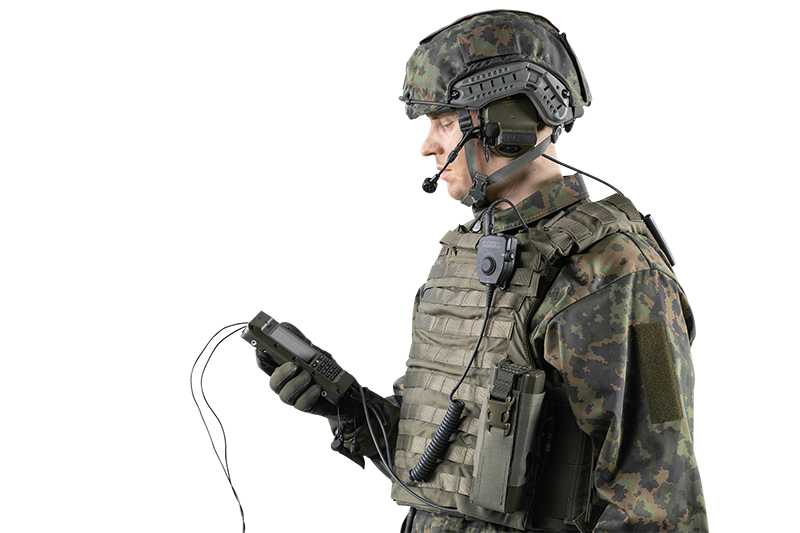Brought to you in partnership with Bittium
When operating in any complex and highly contested environment, every echelon of a combat force should benefit from an aggregated network of networks providing assured, resilient and secure levels of connectivity.
Designed to ensure operational advantage at the tactical ‘edge’, flexible connectivity architects provide units with primary, alternative, contingency and emergency (PACE) communications across every battlespace domain, providing commanders levels of redundancy when it matters most.
According to Bittium’s Vice President for Defense and Security, Harry Romppainen, modern armed forces must use whatever means they can communicate across a battlespace, no matter where they are operating.
‘Our view is that no single technology should be relied upon to ensure tactical communications,’ Romppainen outlined.
He highlighted the ability of modern armies to call upon a range of connectivity solutions stretching from mobile, ad hoc and cellular through to line-of-sight (VHF) and beyond-line-of-sight (UHF) networks.

Seeking to expand the number of connectivity networks available to multi-domain forces on land and at sea, Finland’s tactical communications champion Bittium is offering up its own military-grade Voice Over Internet Protocol (VoIP) solution.
VoIP is a modern and flexible technology to lead troops with voice communications. It brings added value to support easy radio communications with distributed, field wire VoIP connectivity should radio communications become jammed or destroyed.
Bittium’s Tough VoIP Service, which can be installed on multiple network router nodes (including Bittium’s TAC WIN, Tough ComnodeTough SDRs and LTE), has been specially designed to support armed forces operating at the tactical edge.
The system provides all echelons with a truly distributed VoIP service that will not be disrupted should a single element become incapacitated.
It provides an alternative to commercial off-the-shelf VoIP solutions, which can often be centralized and limited in terms of mobility – a critical capability when required to support operations.
Commercial VoIP solutions can be difficult to reconfigure, while integrating VoIP into legacy combat radio networks is equally challenging. Legacy VoIP can also suffer from reduced quality of service, with priority calls sometimes entirely unsupported.
Designed as a more robust solution, Bittium’s Tough VoIP Service can be networked to legacy voice radios using Radio over IP (RoIP) gateways hosted on the company’s very own TAC WIN tactical routers and the Comnode device.

Tough VoIP Service requires zero configuration ahead of or during use with end users not restricted to a single server. Tough VoIP Service supports standard SIP (Session Initiation Protocol) interfaces which enable the employment of terminal devices and trunk connections to third-party VoIP systems.
VoIP calls can also be prioritized within the voice service.
Furthermore, multiple VoIP calls can be managed when using the Bittium TAC WIN Call Admission Control (CAC) solution in Bittium’s TAC WIN network. The CAC alerts end users if the network capacity cannot support a call with low priority calls being canceled, generating greater network capacity for higher priority calls.
Bittium’s VoIP Service is supported by various products, also designed and developed by the Finnish company.
Examples include the Bittium Tough Comnode – a rugged terminal and IP communication device for tactical networks, which the company has designed to meet the data transfer requirements of mobile troops operating at the edge.
Tough Comnode provides telephony and SIP server functionalities across the VoIP network, providing a wireless access point for mobile clients and enabling CNRs into an IP-based tactical communication system.
Tough Comnode also includes field wire, Ethernet, USB, WLAN, BT and GPS connectivity. It also features the Bittium Tactical Network Management solution for easy network and node management, even in field conditions.
The system is fully developed and already in service with the Finnish Defense Forces, enabling enhanced communications and situational awareness. Bittium has also designed an audio extension module to increase capability yet further.

Meanwhile, in April, the company launched the Tough VoIP Field Phone 2, an upgraded variant of its predecessor, which can be used for tactical IP-based communications.
Together with the distributed Tough VoIP Service, calls between the Field Phone 2 users are enabled regardless of how the users are connected to the network.
According to Jari Sankala, Senior Vice President of Bittium’s Defense & Security product and service area, this helps maintain ‘situational awareness in the rapidly changing conditions of the battlefield’.
The company’s IP-based solutions, including VoIP, have been designed to also suit hybrid networking, which can include civilian technology, such as 5G networking. Indeed, Bittium is already positioned to adopt 5G into its network plans, pending customer requirements.
This, Romppainen explained, will occur when it makes operational and commercial sense for customers and the company.
Bittium has high hopes for 5G, and we believe it complements our SDR technology. We are running demonstrations and studies on how to integrate 5G into wider, aggregated communications plans, so we know how to do it. That’s how we see things going in the future, ‘he concluded.

